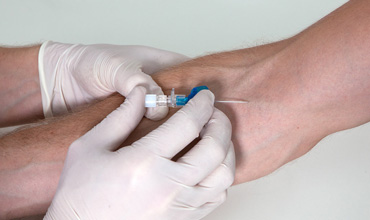Immediate Reactions to Intravenous Injection of Iodinated Contrast Media in a Tertiary Health Facility in Lagos, Nigeria

Abstract:
OBJECTIVE
Adverse reactions to iodinated contrast media
constitute a major challenge in radiography practice. This study was aimed at
establishing the prevalence of such reactions in our environment so as to plan
for more effective management.
MATERIALS & METHODS
A total of 750 patients were approached for this
study, but only One hundred and fifty patients participated. They were those
referred for Intravenous Urography (IVU) and Computed Tomography (CT) Scans
involving intravenous injection of Urografin 76%, at the Lagos University
Teaching Hospital (LUTH) Lagos, Nigeria. A semi-structured questionnaire was
used to capture the patient’s demography, experience during the procedure and
adverse reactions observed.
Data were analyzed using a soft ware package EPI
Info 3.5.1 and results were tested at 5% level of significance.
RESULTS
A very high prevalence of immediate adverse reaction
of 92.7% was revealed. Use of ionic, high - osmolar contrasts agent, level of
anxiety, suspected poor storage condition and handling by the importing vendors
accounted for this high degree. History of allergy had no significance, while
rapid injection rate was associated with increased prevalence. Most adverse
reactions occurred within 5mins of injection of the contrast medium.
Nausea (63%), and Dizziness (50.4%) were the most
two adverse reactions that manifested.
CONCLUSION
Majority of patients in
this study suffered adverse reactions due to the use of ionic contrast agent.
Non ionic contrast agents should replace ionic contrasts, in spite of the high
cost. However, adequate precautionary measures should be put in place if the
use of ionic contrast agent is inevitable.
KEY WORDS
Acute adverse reaction, contrast media, radiographic
procedures, risk factors.
References:
1. American
College of Radiology (ACR) Manual of contrast media, 2010, Version 7.
2. Ansell,
G., Tweedle, M. C., West, C. R., Evans, P. & Couch, L. (1990). The current
status of reactions to intravenous contrast media, Invest Radiol, 15: S32-S39
Medline.
3. Beatriz,
C.J. & Clarice, M.D. (2007) Immediate adverse reactions to intravenous
iodinated contrast media in computed tomography, Revista Latino – Americana de
Enfermagem, Vol. 15, No. 1 Ribeirão Preto. Jan/Feb.
4. Christensen,
C. (2005). X-Ray contrast media – an overview. Toxicology, 209, 185-7.
5. Dickson,
M. C. & Kam, P. C. A. (2008). Intravascular Iodinated contrast Media and
the Anaesthetist, Journal of Anaesthesia, Vol.63 (6), 626-634.
6. Djikmans,
P. A., Visser, C.A. & Kamp, O. (2005). Adverse Reactions to Ultrasound
contrast Agents: Is the Risk Worth the Benefit? European Journal of
Echocardiography, volume 6, Issue 5, 363-366.
7. Katayama,
H., Yamaguchi, K., Kozuka, T., Seez, P. & Matsuura, K. (1990). Adverse
reactions to ionic and nonionic contrast media: a report from the Japanese
Committee on safety of Contrast Media : Radiology, 175, 621-628.
8. Katzbery,
R. W. (2008). Acute Reactions to Urography Contrast Medium: Incidence, Clinical
Characteristics, and Relationship to History of Hypersensitivity States –A
Commentary. American Journal of
Roentenology, 190. 431.
9. Lang,
D. M., Alpern, M. B., Visintaine, P. F. & Smith, S. T. (1995). Gender risk
for anaphylactoid reaction to radiographic contrast media, J Allergy Clinical
Immunology; 95:813-7.
10. Lasser,
E. C. & Berry, C. C. (1989). Nonionic vs Ionic Contrast Media: What Do the
Data Tell Us, American Journal of Roentenology,
152, 941-949.
11. Lasser,
E. C., Lyon, S. G. & Berry, C. C. (1997). Reports on contrast media
reactions: analysis of data from reports to the U.S. Food and Drug
Administration, Radiology, 203, 605-610.
12. Maddox,
T. G. (2002). Adverse Reactions to Contrast Material: Recognition, Prevention
and Treatment, American Family Physician, Vol.66. No 7, 1229-1234.
13. Manouchehr,
S. (2012).Intravenous Radio-contrast Media: A review of Allergic Reactions. US
Pharmacyst, 37(5), Hs14 – Hs16.
14. Modi,
D. J., Mahyavanshi, D. K., Kotecha, J. K., Ashutosh, D. & Harshad, S.
(2012). Adverse reactions to intravenous iodinated contrast media: a
prospective study, International Journal of Basic & Clinical Pharmacology,
Vol. 1, Issue 3, 211- 215.
15. Morcos,
S. K. (2005). Acute serious and fatal reactions to contrast media: our current
understanding. The British Journal of Radiology, 686-693.
16. Morco,
S. K. & Thomsen, H. S. (2001). Adverse reactions to iodinated contrast
media. Euro Radiology, 12, 2600-2605.
17. Morcos,
S. K., Thomsen, H. S. & Webb, J. A. W. (2001). Contrast Media Safety
Committee of European Society of Urogenital Radiography; Prevention of
generalized reactions to contrast media: a consensus report and guidelines.
Euro Radiology, 11, 1720-1728.
18. Panitan,
P., Naruemon, D., Kowit, J., Surrerat, J. & Torponf, T. (2013). Adverse
Reaction to Iodinated Contrast Media: Prevalence, risk factors and outcome –
the result of a 3year period, Asian Pac J Allergy Immunol 31, 299 – 306.
19. Rawlins,
M. D. (1981). Clinical pharmacology: adverse reactions to drugs. BMJ 282974-976.
20. Shehadi,
W. H. (2008). Adverse Reactions to Intravascularly Administered Contrast Media:
A Comprehensive Study Based on Prospective Survey. American Journal of
Roentgenology, 190, 187-190.
21. Speck,
U., Mutzel. W, & Weinmann, H. J. (1983) Chemistry, Physiochemical and
Pharmacology of known and new contrast media for Angiography, Urography and
CT-enhancement, fortschr, Rontgenstr.
118, 2-10
22. Thomsen,
H. S. & Morcos, S. K, (2000). Radiographic contrast media, BJU
International, 8, 1-10.
23. Wang,
C. L., Cohhan, R. H., James, H. E., Caoili, E. M., Wang, G. & Francis, I.
R. (2008). Frequently; Outcome, and appropriateness of Treatment of Non-ionic
Iodinated Contrast Media Reactions. American journal of Roentgenology, 409-419.
24. Wang,
D. Y., Forslund, C., Persson, U. & Wiholm, B. E. (1998). Drug-attributed
anaphylaxis, Pharmacoepidemiol Drug Safety, 7, 269-74.

